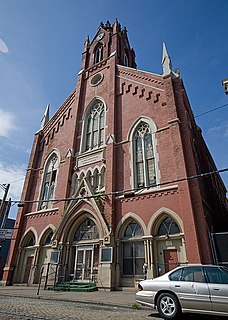
The Apostolic Bethlehem Temple Church is a historic church building in the Over-the-Rhine neighborhood of Cincinnati, Ohio, United States. A German Gothic Revival structure built in 1868, it was constructed as the home of the German Evangelical and Reformed Church, Cincinnati's oldest German Reformed Church. Founded in 1814, the church changed its name to "St. John's German Protestant Church" in 1874, although it remained in the German Reformed Church. This situation continued until 1924, when it departed for the American Unitarian Association and changed its name to "St. John's Unitarian Church." Little more than twenty years later, the congregation abandoned its old building, leaving it vacant until it was purchased by the present owners, a Pentecostal church.
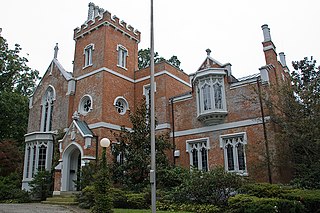
The John S. Baker House is a historic house in the East Walnut Hills neighborhood of Cincinnati, Ohio, United States. Built in 1854 according to a design by Cincinnati architect James Keys Wilson, it was the home of New Jersey native John S. Baker, who settled in Cincinnati in 1814.
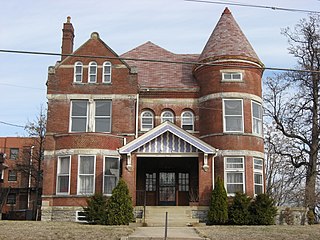
The C.H. Burroughs House is a historic former house in Cincinnati, Ohio, United States. Constructed at the end of the nineteenth century by one of the city's most prominent architects, the house has been converted into a social club, but it retains enough of its integrity to qualify for designation as a historic site.

The Captain Stone House is a historic house in Cincinnati, Ohio, United States. A Romanesque Revival structure built in 1890, it was designed by Samuel Hannaford and Sons for leading Cincinnati citizen George N. Stone and his wife Martha E. Stone, who was a survivor of the sinking of the Titanic, and their two daughters. A native of New Hampshire who served as an officer in the U.S. Army during the Civil War, Stone moved to Cincinnati after the war and became a leading businessman. After Stone's lifetime, the house became a center for a Cincinnati chapter of Alcoholics Anonymous, which continues to host meetings at the property.

The Stephen Decker Rowhouse is a historic multiple residence in the Columbia-Tusculum neighborhood of Cincinnati, Ohio, United States. Built in 1889, it occupies land that was originally a portion of the wide vineyards of Nicholas Longworth. In 1869, after his death, Longworth's estate was platted and sold to builders who constructed a residential neighborhood along Tusculum Avenue. One of the most unusual buildings was the Decker rowhouse, which features multiple distinctive Victorian elements. Chief among these is the ornamentation on the porch roofs: they include gabled rooflines and beveled corners supported by multiple spindles. Connecting these porch roofs are low normal roofs, which primarily protect the recessed entrances to the houses. Elsewhere, the houses feature double-hung windows, imbricated shingles on the gables, and arcades of Gothic Revival panelling, and numerous ornamental circles inscribed within squares. Taken as a single building, the rowhouse measures two bays wide and eighteen bays long; it is of frame construction and two stories tall. Rated "outstanding" by an architectural survey in 1978, it is the only rowhouse of its type in Cincinnati, due to its well-preserved Victorian architecture.
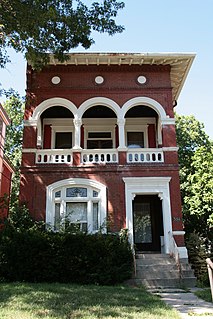
The Moses Goldsmith Building is a historic residence in Cincinnati, Ohio, United States. Built in 1900, it was originally owned by Moses Goldsmith, the president of a firm that sold notions; rather than living in the house, Goldsmith built it for investment purposes, renting it to others.
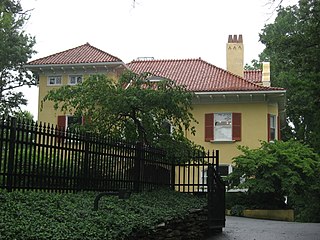
The George Hoadley Jr. House is a historic residence in the Hyde Park neighborhood of Cincinnati, Ohio, United States. Built in 1900, it has been named a historic site because of its unusual construction.

The LuNeack House is a historic residence in the Columbia-Tusculum neighborhood of Cincinnati, Ohio, United States. Built in 1894, it is a frame building with clapboard walls, two-and-a-half stories tall. The overall floor plan of the house is that of a rectangle, with the front and rear being the shorter sides, although the original shape has been modified by the extension of the rear and a hexagonal bay on the western side.

The S.C. Mayer House is a historic house in the Over-the-Rhine neighborhood of Cincinnati, Ohio, United States. Constructed in the late 1880s, it has been recognized because of its mix of major architectural styles and its monolithic stone walls. Built by a leading local architect, it has been named a historic site.

Pilgrim Presbyterian Church is a historic church building in the Mount Adams neighborhood of Cincinnati, Ohio, United States, near the Ida Street Viaduct. Built in 1886, it is a Gothic Revival structure built primarily of brick. Constructed by Mount Adams architect and builder Charles E. Iliff, the church features a two-story rectangular floor plan with a prominent central bell tower. Among its other distinctive architectural elements are the rose windows in the main gable, pairs of windows on its second floor, and the symmetry evidenced in the overall design of the building.

Scarlet Oaks is a large and historic residence in the Clifton neighborhood of Cincinnati, Ohio, United States. Built in 1867, it was designed by James Keys Wilson and features a mix of the Romanesque Revival and Gothic Revival styles of architecture.

The Daniel Thew Wright House is a historic residence in the far western part of Cincinnati, Ohio, United States. Located in the neighborhood of Riverside, it was originally home to lawyer and federal judge Daniel Thew Wright, and it has been named a historic site because of its distinctive architecture.

Hunting Lodge Farm is a historic house located near Oxford in Oxford Township, Butler County, Ohio, United States. Constructed as a hunting lodge, it has been used by multiple prominent local residents, and its distinctive architecture has made it worthy of designation as a historic site.

The John H. Nichols House is a historic house in downtown Wapakoneta, Ohio, United States. Built in 1865, it is Wapakoneta's oldest example of the Greek Revival style of architecture. Among its leading features are a three-bay facade with a prominent gable, large entablature, and cornices under the roof, several large windows on the front and sides, and a trabeated entryway framed by several sidelights and a transom supported by two brackets.
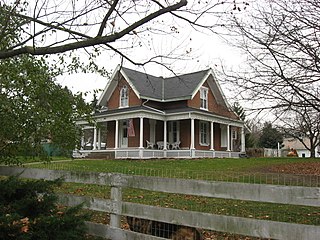
The Fulton Farm, also known as "River Bend Farm," is a historic farmstead in Shelby County, Ohio, United States. Located on the southern side of the city of Sidney, the farm is composed of five buildings spread out over an area of approximately 2 acres (0.81 ha). Built primarily in 1848, the distinctively Gothic Revival farm buildings are a leading element of Shelby County rural architecture; few pre-Civil War farmhouses elsewhere in the county are more elaborate. Besides the farmhouse, the complex includes four less important buildings, two brick and two wooden: a smokehouse, a carriage house, and two smaller barns.
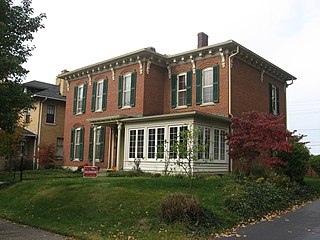
The Ansel T. Walling House is a historic house in Circleville, Ohio, United States. An Italianate structure that was built in 1869, it was the home of Ansel T. Walling, a state and federal legislator.

The Matthew McCrea House is a historic house in Circleville, Ohio, United States. Located along Main Street on the city's eastern side, the house mixes elements of the Greek Revival and Italianate architectural styles.
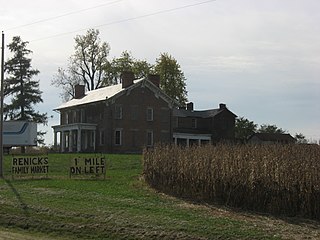
The Renick Farm is a historic farmstead located along U.S. Route 23 near the village of South Bloomfield in northern Pickaway County, Ohio, United States. Composed of six buildings dating back to 1830, the farmstead has been designated a historic site because of its unusually well-preserved architecture.

Lawler's Tavern is a historic commercial building in the village of Mechanicsburg, Ohio, United States. Built in 1830, it is one of the oldest buildings in the community, and it has been named a historic site.
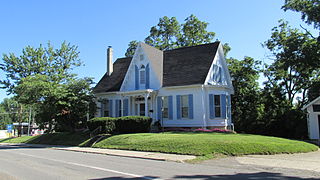
The Robinson-Pavey House is a historic residence in western Washington Court House, Ohio, United States. Named for its two prominent earliest residents, the house has been named a historic site.






















